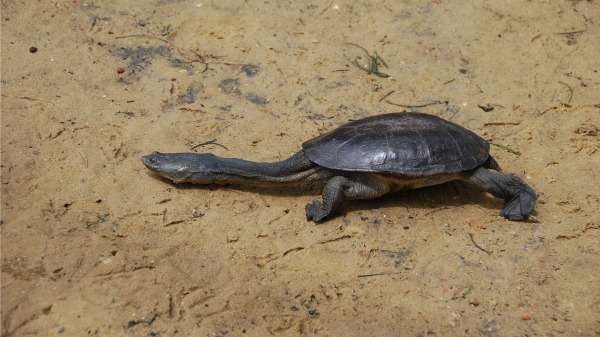Rescued turtles turn up new parasite

A wild turtle, left tethered to a stake through a hole stabbed into her neck, is one of five rescued western long-necked turtles (Chelodina colliei) subsequently found to host an entirely new species of Eimeria parasite.
This was discovered when volunteers at Perth's Turtle Oblonga Rescue and Rehabilitation Network took the rescued turtle and 24 others—mostly the victims of traffic accidents, attacks by pets and habitat destruction—into care.
When Kanyana Wildlife Rehabilitation Centre's Belinda Brice discovered evidence of Eimeria-like parasites in faecal samples collected from the rescued turtles, she sent the samples to Murdoch University's Dr Rongchang Yang.
"We tested samples from all 25 turtles for the presence of spore-like oocysts, which are very characteristic of Eimeria parasites," Dr Yang says.
"We found that five turtles, including the injured turtle, were shedding Eimeria."
Dr Yang followed up Ms Brice's initial microscopic observations with modern molecular techniques, combining the two in an attempt to identify the parasite.
"We were able to use a micromanipulator to select morphologically identical oocysts, one by one, then we extracted their DNA," he says.
Dr Yang then used polymerase chain reaction, or PCR, to target three genetic sites on the oocyst's DNA, attempting to detect tell-tale gene fragments that could help place the Eimeria species relative to its genetic family.
"Analysis revealed that the Eimeria detected is a new species, and is genetically distinct from other identified Eimeria species," Dr Yang says.
After undergoing several surgeries—and testing negative for the parasite—the injured turtle was rehabilitated back into the wild, along with three of the other five Eimeria-positive turtles.
None of the turtles displayed clinical signs of coccidiosis—disease caused by parasites including Eimeria.
A first for Australian turtles
The parasite species, named Eimeria collieie, is the first in more than 1700 described Eimeria species worldwide to be characterised from Australian turtles.
"There is a lack of basic knowledge on the biodiversity and pathogenesis of coccidian parasites in native reptile, marsupial and bird populations," Dr Yang says.
"We are working to establish this baseline data to better understand the disease risks to reptiles, marsupials and birds, as well as humans."
The ongoing project is being led by Murdoch parasitology expert Professor Una Ryan.
The western long-necked turtle is found in metropolitan Perth and across the south-west.
It shares its range with the critically endangered western swamp tortoise (Pseudemydura umbrina).
More information: www.sciencedirect.com/science/ … ii/S0014489415001083
Provided by Science Network WA



















